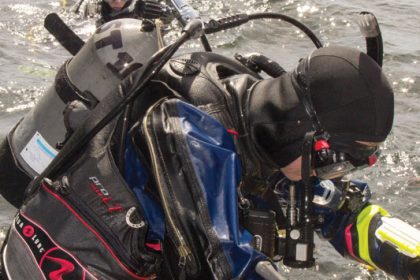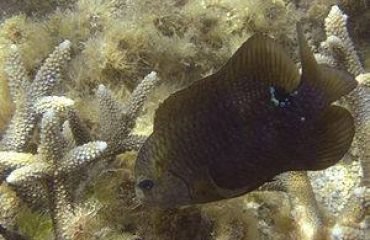Hernias: Issues for Divers

There are many different kinds of hernias. A hernia is the protrusion of an organ or its fascia through the wall of the cavity that normally contains it. Some hernias are very common and some quite rare. Each has a different implication for the diver and his or her diving safety. A diver who has a hernia should consider several things before s/he decides to dive. These include: activity limitations that may result from the hernia, the possibility that the hernia may be made worse from the heavy lifting usually associated with diving, the risk of the contents of the hernia becoming trapped during a dive and concerns about any gas contained in the hernia. Diaphragmatic Hernia The diaphragm is a flat sheet of muscle that separates the chest from the abdominal contents. It is dome-shaped, so that when the diaphragm contracts, it pulls down. This pushes the abdominal contents out of the way and enlarges the space in the chest, allowing air to move into the lungs. The diaphragm is normally intact, but in approximately one of every 2,000 babies born, there is a hole or holes in the diaphragm that can allow some of the abdominal contents to protrude into the chest. If the defects are large, surgery is required soon after birth. Diaphragmatic hernias can also develop later in life, after abdominal trauma or after surgery on the abdomen, especially the spleen. If any abdominal contents are herniated into the chest through a hole in the diaphragm, the patent should avoid diving until after the hole has been repaired and the patient has recovered from the surgery and/or been cleared for unrestricted activity by the surgeon (typically 6 to 8 weeks). Hiatal or Hiatus Hernia The hiatus is an opening in the diaphragm and a hiatus hernia (HH) is a special kind of diaphragm hernia. The esophagus runs from the back of the throat to the stomach. The connection between the esophagus and the stomach normally occurs in the diaphragm. At this junction there is a muscular ring (lower esophageal sphincter, LES) that keeps the connection closed so that acid and food does not move from the stomach back up into the esophagus. When you swallow, the liquid or food moves down the esophagus and when it reaches the LES the muscles relax, allowing the liquid or food to pass into the stomach. A hiatal hernia occurs when part of the stomach protrudes into the chest. There are two main kinds of hiatal hernias: sliding and paraesophageal (next to the esophagus). It is rare, but possible, for a person to have a combination of the two types. In a sliding HH, the junction between the esophagus and the stomach has moved into the chest, so that part of the stomach is in the chest. This is by far the most common type (95%) of HH. In a paraesophageal HH, the junction between the esophagus and the stomach is in the normal place in the diaphragm but part of the stomach has ‘herniated’ into the chest beside the esophagus. Hiatal hernia is extremely common. One reference has stated that 60% of people over age 50 have a HH. Risk factors for HH include heavy lifting, coughing, sneezing, pregnancy, violent vomiting, constipation and obesity. Basically, anything the raises the intraabdominal pressure on a frequent or violent basis can push the stomach up into the chest. Heredity, smoking, drug use and stress are also risk factors. Hiatal hernias are normally asymptomatic and cause no problems. Symptoms occur in less than 10% of people with HH. The most common are associated with movement of acid and stomach contents back into the esophagus (heartburn). It is thought that the muscles of the diaphragm help keep the LES closed. If the LES has moved up into the chest (sliding HH) that support is lost and reflux is more likely. Anyone with significant reflux should not dive until the reflux is under control. Imagine swimming head down during a dive and having acid come up into your mouth, or, worse, get aspirated into your throat and lungs causing you to choke. Not a great idea during a dive! Weight loss can be highly effective in reducing reflux as it reduces the pressure on the stomach. I have a very strong motivation to keep my weight under control, as every time it creeps up I suffer from heartburn. Medications are often used to control symptoms, including acid reflux. A BCD with integrated weights puts much less pressure on the stomach than a weight belt and can help. In a paraesophageal HH (or a mixed HH), the top part of the stomach is in the chest and often contains a gas bubble. This part of the stomach could become trapped during a dive and/or it could rupture. Most diving medical authorities consider a paraesophageal HH a contraindication to diving. In a sliding HH there is very little risk of the stomach becoming trapped. As long as the patient does not have significant symptoms, they can dive safely. If the esophagus is frequently exposed due to stomach acid, permanent damage and scarring occurs. These patients and other patients with serious symptoms often require surgery to repair the HH. The most common procedure is to wrap the top part of the stomach around the bottom of the esophagus. This reinforces the LES and prevents the stomach from herniating into the chest. The surgery is now usually performed through a laparoscope and recovery is typically quite quick (a few weeks). Once the patient has recovered from the surgery and has been cleared for full activities by the surgeon, s/he can return to or take up diving. Some patients suffer side effects from the surgery. The most common is gas-bloat syndrome, where the patient is unable to expel gas that has been swallowed and entered the stomach (they cannot burp). These patients should not dive until the symptoms have resolved (typically a few weeks or months). Internal Abdominal Hernias Internal abdominal hernias are hernias entirely inside the abdomen. They are relatively rare but the most common occur after major abdominal surgery or an infection where bands of scar tissue have formed. A loop of bowel can slide through a small opening and become trapped. This can result in strangulation of the loop of bowel and a surgical emergency. Other forms of internal abdominal hernias can result from congenital defects and include paraduodenal hernias, hernias through the foramen of Winslow, transmesenteric hernias, pericecal hernias, intersigmoid hernias and paravesical hernias. The bottom line is that all of these are rare and you usually only find out you have one when a problem arises. The major concerns for divers with internal abdominal hernias are: the possibility a surgical emergency arising during a dive; and expanding gas in the intestine, resulting in trapping of the loop of bowel in the hernia and potential rupture of the bowel. If you know you have one of these hernias you should not dive until after it is fixed and you have recovered from the surgery. Next time I’ll review the other common hernias: umbilical or ventral, incisional and inguinal/femoral.





![Astrid_and_Andreas[1]](https://siamscuba.com/wp-content/uploads/2015/09/Astrid_and_Andreas1-370x240_c.jpg)